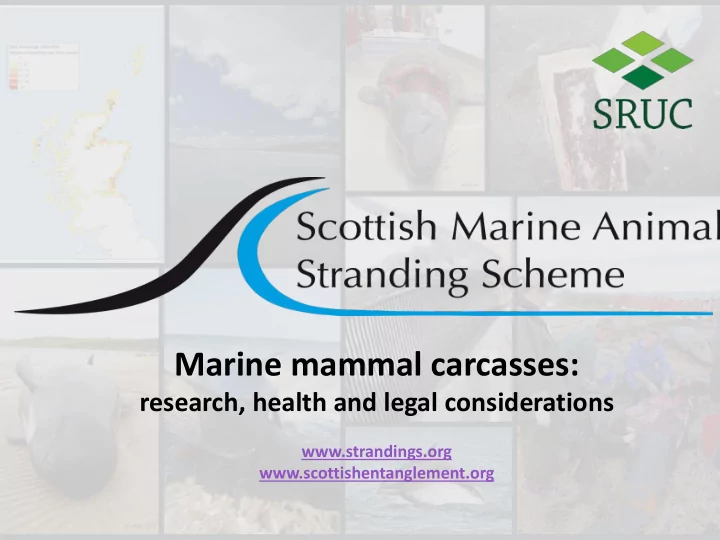

Marine mammal carcasses: research, health and legal considerations www.strandings.org www.scottishentanglement.org
Who? • Operational since 1992 • Part of the Cetacean Strandings Investigation Programme (CSIP) • Funded by Scottish and Westminster govt • Team of four based in Inverness Aims: • To collate, analyse and report data for marine strandings (8500 strandings records, 22 species) • To determine the cause of death in stranded animals (2000+ necropsies) • To undertake surveillance in order to identify any substantial new threats to their conservation status
Why? • Assess health and ecology of species – how it lived and why it died • Insight into wider metrics e.g. age structure, reproductive patterns and diet • Provide baseline data to detect and assess trends and patterns in strandings, disease outbreaks, unusual mortality events, environmental and anthropogenic stressors plus potential conservation issues • Contributes to assessment of and for specific conservation measures
SMASS volunteer network • ~ 200 trained volunteers • Where immediate collection of carcasses for necropsy examination is not possible, volunteers collect photographs, morphometrics and tissue samples. • Help from trained volunteers is invaluable but safety is paramount . There are risks which must be taken seriously…
What we need to know • 2 levels – Level 1: essential – Where – When Photographs ! – What – Level 2: additional – Size – Condition – Sex – COD indicators – Access
Risks • Location hazards – Tide, daylight, sand/mud, loose rocks, bad weather, exposure, getting lost, getting stuck, getting to the site, other beachgoers and their dog…
Risks • Sampling hazards – Stab injury, slicing injury, puncture injury – Teeth, bone fragments, knives – Infectious disease: Inhalation, skin contact • Seal finger • Brucella spp • Salmonella • as yet unknown zoonosis…
Questions the SMASS team have been asked…. – Are you going to eat that? – Can I eat it? – Oh it’s so pretty, can I pet it? – Why are you killing that animal? – Can you get rid of it? – Can I take a bit as a souvenir?
Legal considerations Species protection: – 1979: Convention on the Conservation of Migratory Species (Bonn Convention) – 1981 Wildlife and Countryside Act – 1992: Annex IV of the Habitats Directive (92/43/EEC) – 1992: Annex II (designation of Special Areas of Conservation) – 1991: Agreement on the Conservation of Small Cetaceans of the Baltic and North Seas (ASCOBANS), – 2004: Nature Conservation (Scotland) Act – 2010: Marine Scotland Act
Legal considerations
Recommend
More recommend